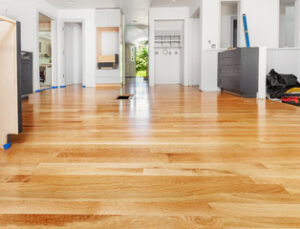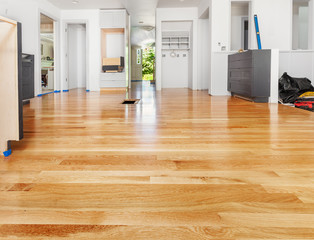Hardwood Floor Refinishing can create a clean, inviting look for your home. Having your floors refinished can also save you money in the long run.

There is a certain pride that comes with completing a wood floor refinishing project yourself. It takes dedication and time, but the finished product is something that homeowners can be proud of.
Hardwood floor refinishing involves stripping down the old finish, sanding, and applying fresh stain to create an entirely new look. A good do-it-yourself project, the process of refinishing is fairly straightforward with the right tools and some patience. But it can also be messy and dangerous, so make sure you take the proper precautions. Tape masking tape to doors and windows to prevent dust from escaping during the process, and consider covering furniture or rugs with plastic sheets or drop cloths. Before you start, check that your sander and equipment are in good working condition. You should also decide whether you want to use water-based or oil-based polyurethane. Water-based finishes remain clear, whereas oil-based ones can yellow with time.
If you’re using a drum sander, work your way around the room, starting in the center and moving outward, taking care to sand under radiators and in corners. If there are dents or gouges in the floors, fill them with wood putty and sand until smooth. You should also sand the edges of the room with an edger, using coarser-grit sandpaper.
Whether you’re staining or just sealing the hardwood, test your color by applying a small amount of diluted stain to a hidden area. If the stain looks even and doesn’t leave a residue when scraped, you can begin the final step of refinishing.
If your floors are stained, wait at least 24 hours before walking on them; you should ideally wait for 4–7 days to allow the finish to fully cure. You should also keep pets away from the work area and open all windows to reduce the odor of the polyurethane.
Some refinishers offer “dustless” flooring, but this isn’t actually completely true. The refinishing process still produces a lot of dust, so it’s best to plan ahead. Leaving your home for the day or weekend will help reduce the amount of fumes you’ll inhale, and you can take a vaporizer with you to make the odors less strong. And if you have sensitive family members or pets, it’s a good idea to find a place for them to stay.
Sanding
When refinishing hardwood floors, the first step is to sand the surface. This is the most thorough method of refinishing and the most costly, but it removes scratches, dents, and stains from the floor, leaving it looking brand new. Before starting sanding, it is important to clear the room completely. This means removing all furniture, wall hangings, and window treatments. It is also a good idea to clear out closets if the wood flooring extends into these areas. Then, cover any fixtures or appliances with plastic tarps to protect them from sawdust. It is also a good idea to tape over electrical outlets and any cracks where dust may sneak in.
Then, sweep the surface of the floor thoroughly and vacuum it to get rid of any dust particles. A slightly damp mop with a microfiber or cloth rag is also helpful to remove any dirt that could mar the finish. After sanding, it is also a good idea to inspect the floor for any damaged or loose boards and secure them. This will make the finished product look much better, and it is an easy way to increase your home’s value when selling it.
After the sanding is complete, it is a good idea to use wood filler on any nail holes or gouges in the floor. This can be purchased at any hardware store and is usually color-matched to the existing floor. Another option is to use some of the sawdust from the sanding process and mix it with white glue to create a paste that can be applied with a putty knife.
Some people opt to use a vacuum-equipped “dustless” sanding machine when refinishing their hardwood floors, but this does not eliminate all the dust; it just reduces it. If you have a dustless sanding machine, it is still necessary to clean the entire floor thoroughly and wipe it down with a damp rag. It is also a good idea to switch the sandpaper on the sanding machine regularly to avoid putting too much pressure on one area of the floor.
Staining
When the sanding process is complete (which can take 2-3 days for a typical room), it’s time to stain the floors. This is the single most important step in hardwood floor refinishing, and it will determine how well your floors look when they’re finished. To help ensure that you get the right color and finish, it’s a good idea to talk with your flooring experts about what you want and ask them to bring samples of various stains for you to test on your floors.
Staining is a messy and labor-intensive process, but it’s also an excellent way to add a custom look to your home. When the stain is dry, it’s time to protect your new floors with a polyurethane sealant. This can be done with a high-density foam roller or, in some areas where you have less space to work, a two-inch brush.
Once the sealer is dry, it’s a good idea to vacuum and wipe the floors down with mineral spirits to remove any residual dust that could interfere with the adhesion of your new finish. Then, you can apply a second coat of polyurethane using the same technique as the first.
Refinishing your wood floors is a great way to improve the look of your home and increase its value. If your wood floors are damaged, however, resurfacing may be a better option than refinishing. Both options have benefits and drawbacks, so consider all your options carefully before making a decision.
Although refinishing is more expensive than resurfacing, it can make your wood floors look like new again. It’s also a great choice for older homes that have seen a lot of wear and tear. In addition to enhancing the beauty of your home, refinishing can also reduce the amount of maintenance required for your hardwood floors. A refinished wood floor is more durable than one that has been resurfaced, and it will last longer. However, refinishing can be tricky and requires professional experience. It’s best to hire a flooring expert who is NWFA certified and has years of experience working on wood floors. They understand the ins and outs of refinishing and can produce results that you’ll be proud to show off to your friends and family.
Varnish
The refinishing process involves the application of various coats of finish to a hardwood floor. A good-quality finish protects the hardwood from moisture, heat, and UV rays. It also adds to the aesthetic value of a room. Generally, three or more coats of finish are applied to the wood during refinishing. Before applying any kind of finish, it’s best to thoroughly clean the floor. This should be done by vacuuming and using a microfiber or tack cloth to remove any dust left behind. It’s important to let the floor dry completely before adding furniture.
The most common type of finish for hardwood floors is polyurethane. This type of finish is durable and easy to use. It comes in a variety of sheens, so you can choose the one that’s right for your home. When choosing polyurethane, make sure it’s water-based and has a low odor. Oil-based polyurethanes have a stronger scent and are more toxic than water-based versions.
You can also choose to varnish your hardwood floors. Varnish is a liquid coating material that dries to a hard, transparent film. It is typically made of a mixture of resin, drying oil, a drier, and a volatile solvent. When the solvent evaporates, the varnish oxidizes or polymerizes to form a tough protective coating for wood surfaces. It can be used on wood floors, furniture, and painting.
If you’re refinishing your hardwood floors yourself, it’s essential to wear the proper safety gear and have enough space to work. You’ll also need a drum sander, a vacuum with a HEPA filter, and cleaning products. It’s also a good idea to take your time so you don’t ruin the floor.
Before you apply a new coat of finish, you should stir it to make sure all of the ingredients are well mixed. This will help prevent air pockets from forming in the finish, which can lead to brittleness and other problems.
Cupping is another problem that can affect hardwood floors. This occurs when the planks start to cave in down the middle. This is usually a sign of water damage, and it’s best to catch it early. Refinishing the hardwood floor will smooth out the planks and prevent future cupping.

